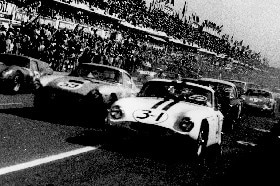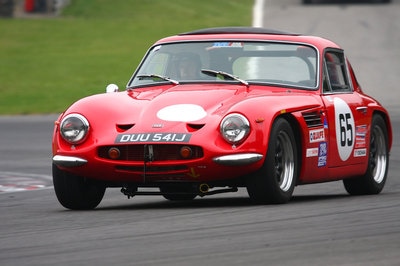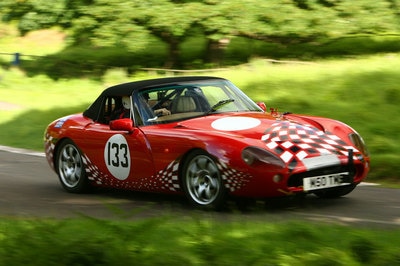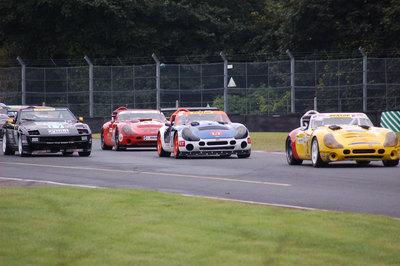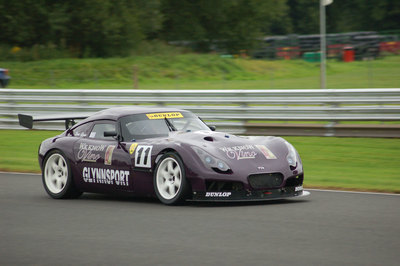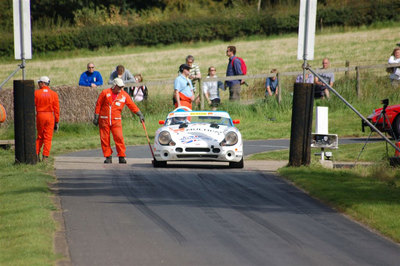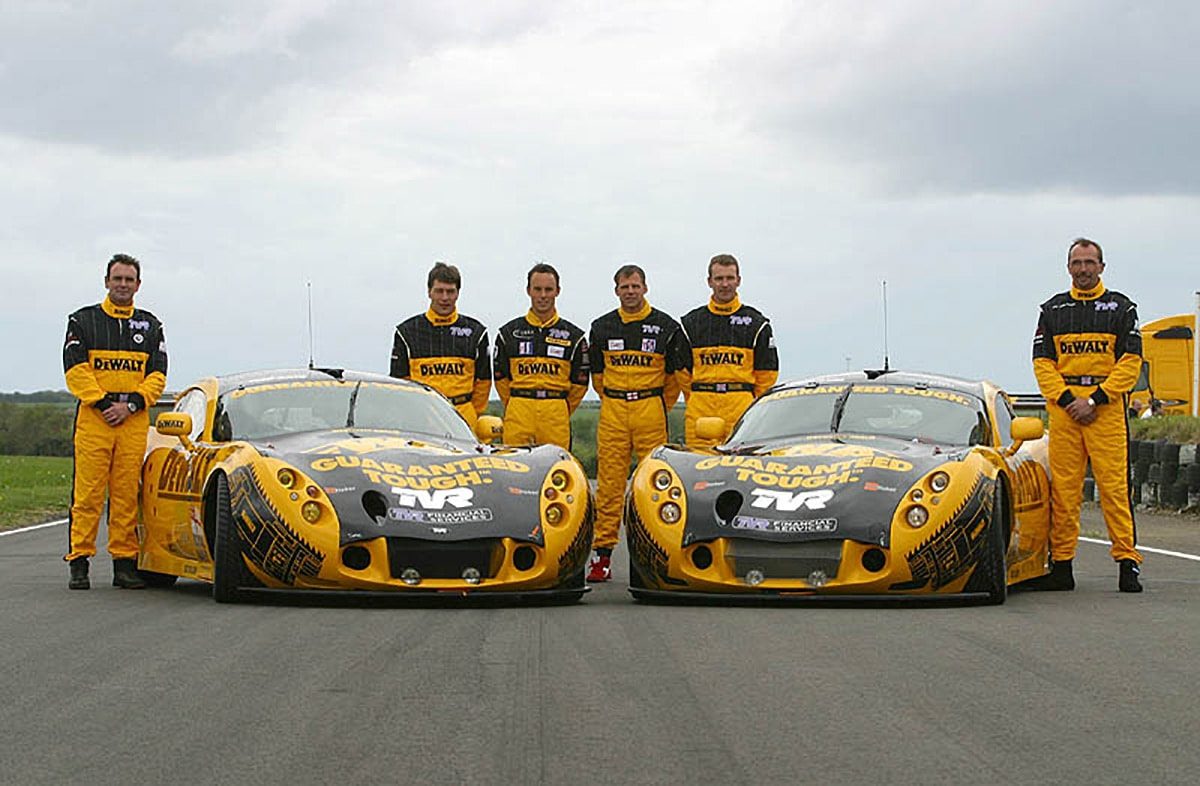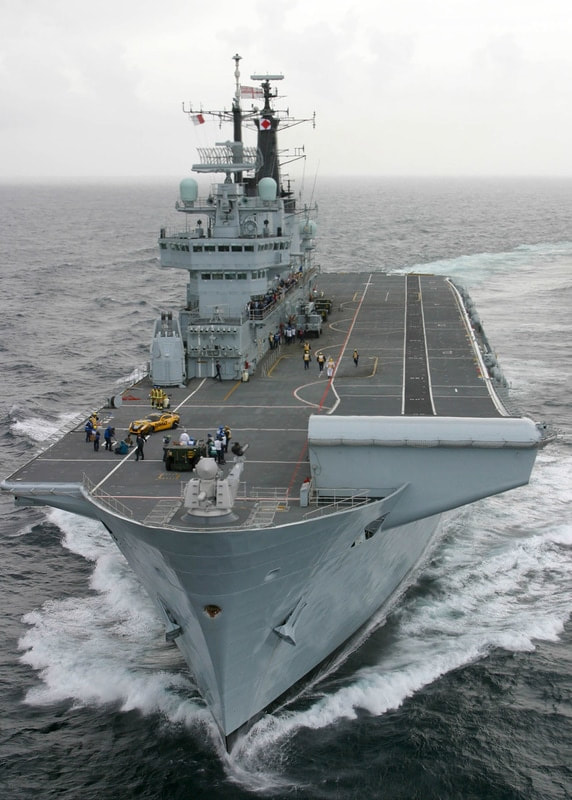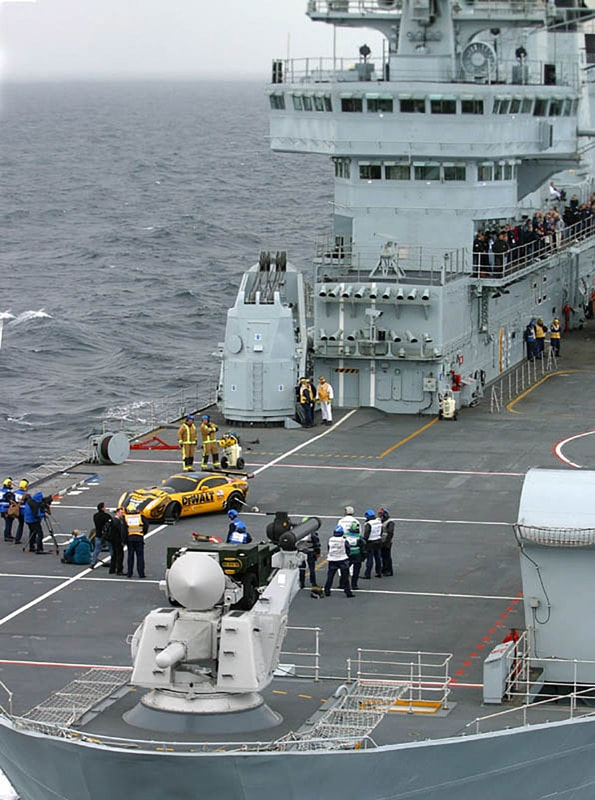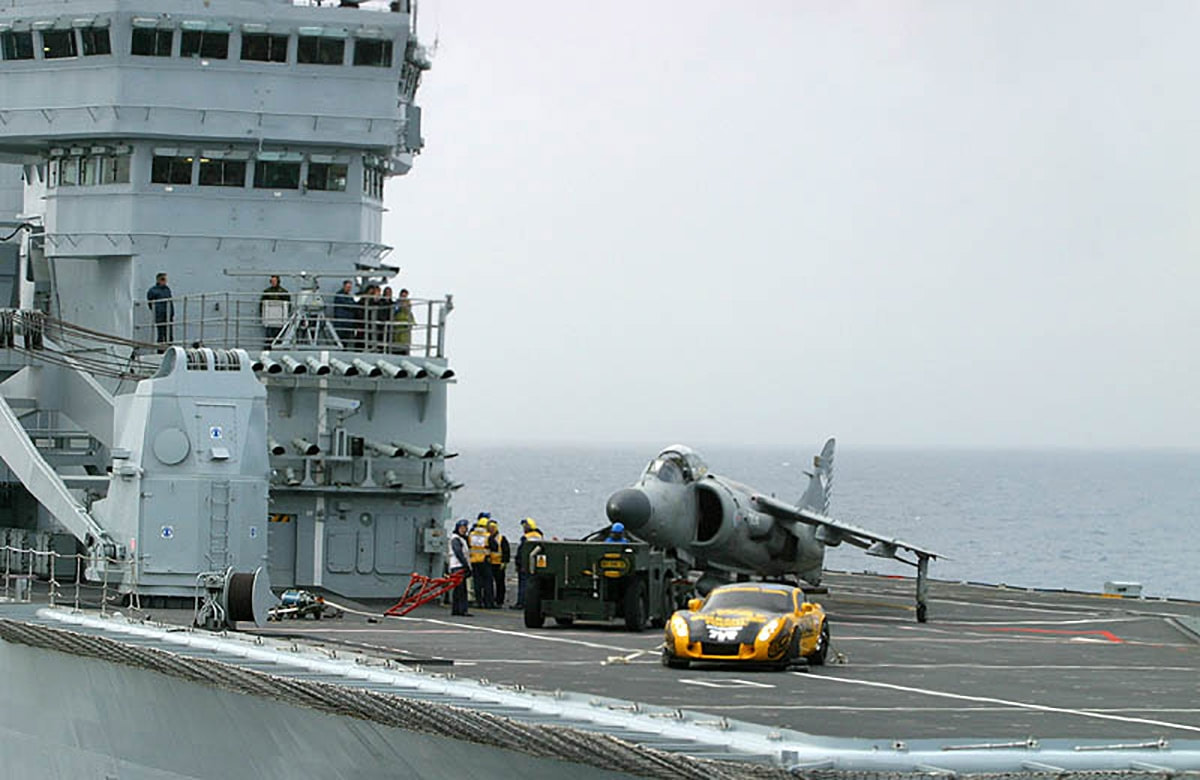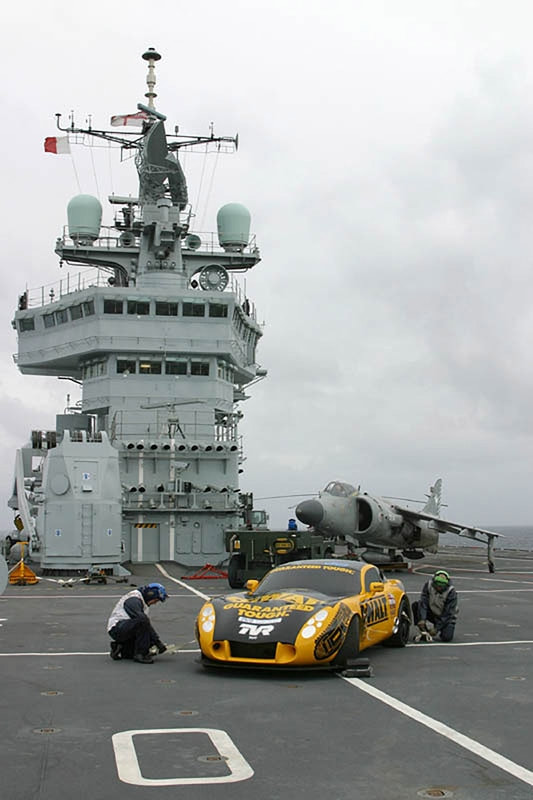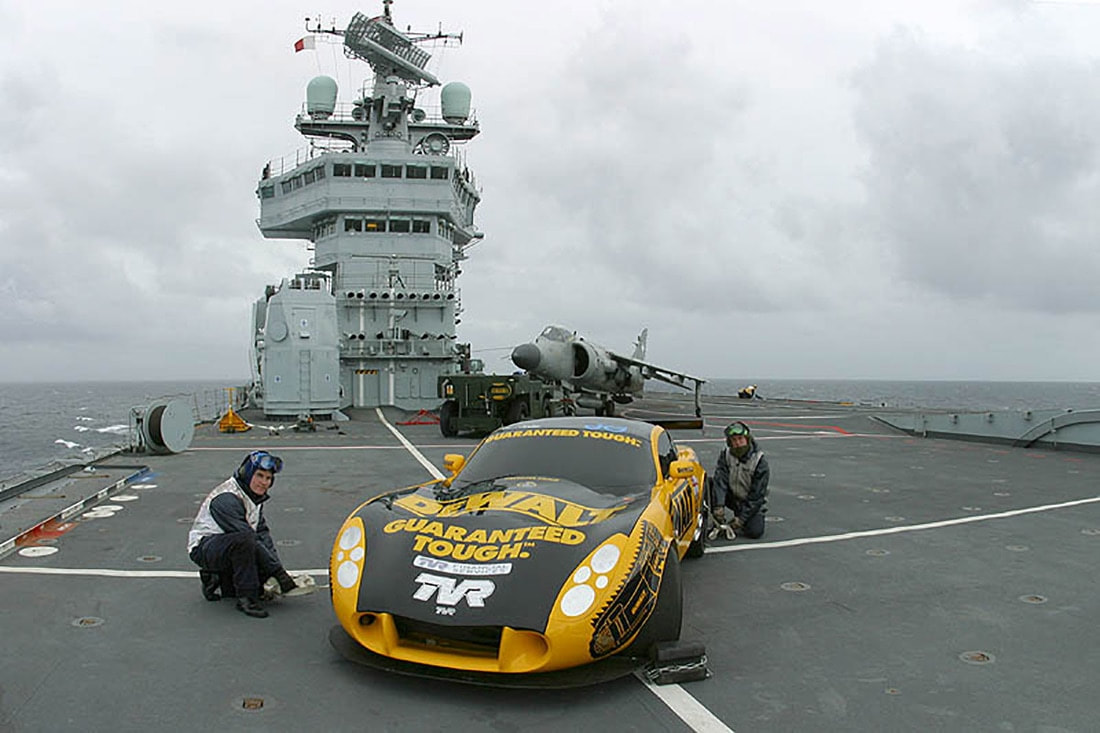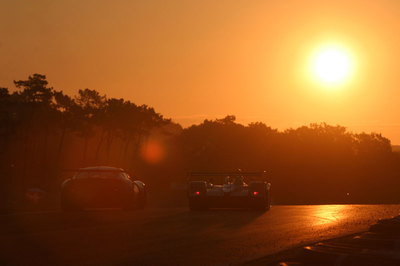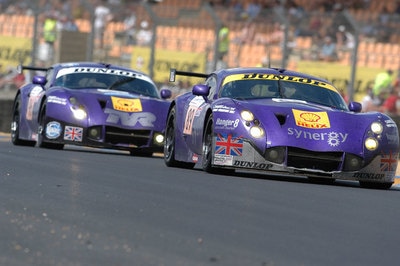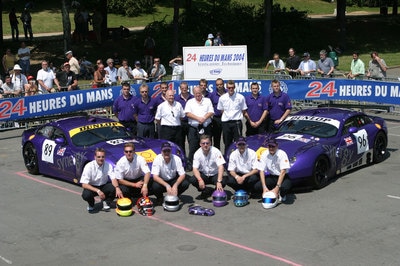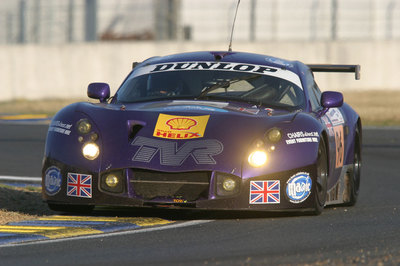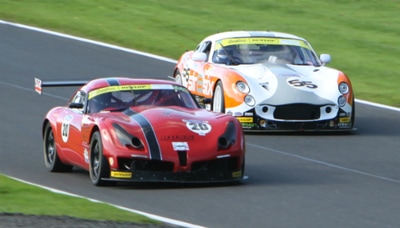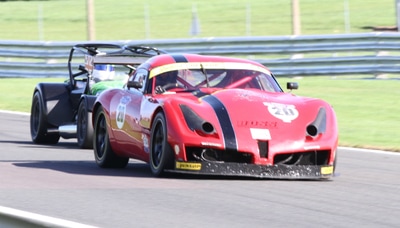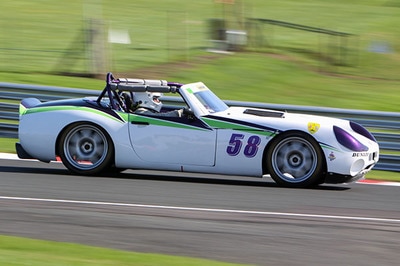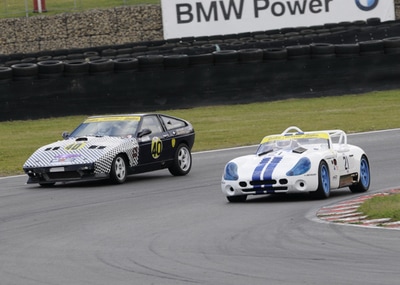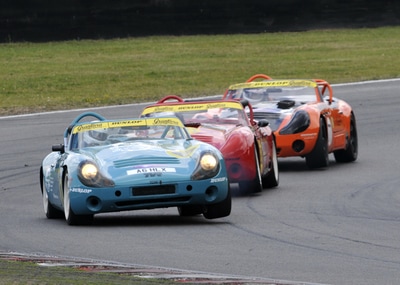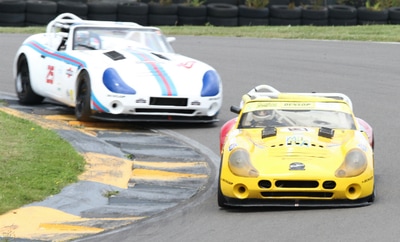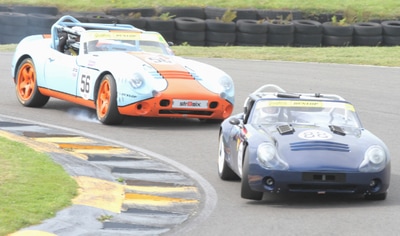TVR Motorsport HistoryTVRs have raced around the world since their inception. Trevor's very first cars, TVR 1, 2 and 3, were all designed for sprinting and racing. 1962 saw a Le Mans attempt with the Grantura, the birth of the Cobra beating Griffith in the USA and numerous successes for the marque in club racing wherever it raced.
The 1970’s brought success in the prodsports championship with Chris Alford in his 1600M and John Kent in his 3000M. The Tasmin flew the flag well through the 1980’s with Colin Blower prominent and this led to the development of the SEAC which first appeared as a race car in 1986 and in the hands of Steve Cole blew away all the opposition in the 1987 750 Motor Club championship winning 21 out 24 races but was eventually banned because TVR had not built enough road examples. |
Consequently, TVR took the what was orginally released as a prototype road car based around the S Series and from that developed the TVR Tuscan racer.
This was arguably the definitive single make race series throughout the 1990s and unlike the claims of many manufacturers that their involvement in motorsport does benefit their road cars, here was proof if ever it was needed that TVR really did do that with many of the parts used on the Griffith and Chimaera road cars first being tested on the track and even the AJP 8 engine that powered the mighty Cerbera was first tested to destruction on the race track in the Tuscans in the 1993 &
The logical extension from the Tuscans was into GT racing and thus 1998 saw the first appearance on the track of the mighty Speed 12 at Oulton Park. Concurrently, Tuscan driver Martin Short campaigned the Cerbera Speed Six in firstly British GT and then FIA GT where he saw success throughout the 2000 season.
From the development work carried out by Shorty's Rollcentre team and work at TVR itself, grew the Tuscan R, launched at the 2000 Motor Show and from which was developed the mighty T400R which saw success in British GT throughout 2001 and 2002, before returning to the international stage with a return to Le Mans in 2003 led by Richard Stanton and the Racesport Salisbury team.
Read more about the spectacular press launch on HMS Invincible here
This was arguably the definitive single make race series throughout the 1990s and unlike the claims of many manufacturers that their involvement in motorsport does benefit their road cars, here was proof if ever it was needed that TVR really did do that with many of the parts used on the Griffith and Chimaera road cars first being tested on the track and even the AJP 8 engine that powered the mighty Cerbera was first tested to destruction on the race track in the Tuscans in the 1993 &
The logical extension from the Tuscans was into GT racing and thus 1998 saw the first appearance on the track of the mighty Speed 12 at Oulton Park. Concurrently, Tuscan driver Martin Short campaigned the Cerbera Speed Six in firstly British GT and then FIA GT where he saw success throughout the 2000 season.
From the development work carried out by Shorty's Rollcentre team and work at TVR itself, grew the Tuscan R, launched at the 2000 Motor Show and from which was developed the mighty T400R which saw success in British GT throughout 2001 and 2002, before returning to the international stage with a return to Le Mans in 2003 led by Richard Stanton and the Racesport Salisbury team.
Read more about the spectacular press launch on HMS Invincible here
Sadly, neither car finished but the cars returned to Le Mans the following year in the hands of Synergy Chamberlain Motorsport and for the first time ever, both TVrs completed the world's most gruelling GT race.
At the other end of the motorpsort spectrum, the TVR Car Club inaugurated an entry level series, the TVR Car Club Tasmin Challenge in 2000 which grew into the TVRCC Challenge Cup in 2004 before merging with the former TVR Tuscan Challenge in 2006. This series, for which the leading TVRCC driver is still awarded the TVRCC Challenge Cup, is now the Dunlop TVR European Challenge.
History of the Dunlop Tuscan Challenge
Text and photos all © Dunlop TVR European Challenge website.
The TVR Tuscan Challenge was a one-make series dedicated to the second incarnation of the TVR Tuscan sports car (developed specifically for the series), and took place throughout the United Kingdom. Inaugurated in 1989, it had high power-to-weight ratio, capability of reaching 190 mph (310 km/h) and loud engine noise, combined with close racing in a field consisting of over 30 cars at its peak, made the series become, at the time, the premier one-make series in the UK with an extensive TV coverage; over the years, many drivers who competed in the series moved on in major championship series and many notable drivers have guest driven in a race. The company underwent management changes in 2005, and factory support for the Tuscan Challenge was withdrawn. Under John Reid (ex TVR motorsport director), the TVR Tuscan Challenge was merged with the TVR Car Club Tasmin series, which has been reformatted to allow for all TVR models under the BRSCC.
A brief history of the Tuscan Challenge:
This version of the Tuscan is not to be confused with either the earlier V8/6 model or the later roadgoing Speed 6 version.
With the success of the S Series, TVR began development of an ES, an S series sports car with a Holden V6 3.8 litre engine. It wasn’t until the 1988 British Motorshow, in Birmingham NEC; the car was unveiled as a prototype with plans for it to be developed for road use, but in order to attract public interests and stimulate sales, TVR resurrected the Tuscan name and at the same time instigated the one-make TVR Tuscan Challenge series.
In order to attract a large field, TVR offered the first batch at a discount of £16,000 plus VAT for entrants with a condition that they commit themselves to compete at least six of the twelve races in the championship. Should that fail, the purchaser would agree to pay the extra £16,000 at the end of the season.
With the instant success of the series in its first year in 1989, plans for a road car fell by the wayside as TVR was busy with the ‘S’ and the older wedge models as well as design and development work for the forthcoming Griffith and Chimaera models.
It never went beyond the motor show prototype stage, and the Tuscans continued to be produced in small volumes as racing cars.
The S based chassis had to be developed to cope with the extreme power outputs of the tuned Rover V8 engine; by the end of its development, it ended up being a completely new chassis with a wider track, increased wheelbase and much strengthening.
Its original output was 350 bhp (261 kW) sourced from the TVR 350i that was transmitted through a Borg Warner T5 gearbox to its nine inch (229 mm) wide wheels. In the early 1990s, as the aging Rover V8 was getting beyond its development limits and Rover’s takeover by BMW, plus Peter Wheeler’s rumoured refusal of having German engines in his cars, Wheeler commissioned engine designer Al Melling to develop the new AJP8 engine, producing more power than its Rover counterpart. With the new V8 engine, the car was capable of 0-60 mph in just over 3 seconds and 0-100 mph in just 6.9 seconds. The cars boasted of 536 bhp (400 kW) per tonne (400 W/kg) with a capability reaching in excess of 190 mph (310 km/h), the cars became popular with race goers. All engines are factory supplied sealed units to ensure a level playing field.
Dealers were usually encouraged to enter the series and the then company owner Peter Wheeler competed in the series, from which he used his expertise to develop the Speed 12, its managing director at the time, Ben Samuelson also competed in the series. Many drivers who are now competing in the Le Mans Series, FIA GT Championship and 24 Hours of Le Mans, such as Jamie Campbell-Walter, Bobby Verdon-Roe, Martin Short and Michael Caine, developed their skills in the series. Nigel Mansell was to compete for a one off race at Donington Park in 1993 but was unable to after he was hospitalised following a BTCC incident. Other drivers who have guest driven in the series throughout its history includes Colin McRae, Andy Wallace, Tim Harvey, Anthony Reid, Tiff Needell and John Cleland.
Carlube sponsored the series between 2002 to 2004 and the series was now renamed Dunlop TVR Challenge. At the end of 2003, a version of the new Sagaris was introduced with an intention to run alongside the racing Tuscan and to eventually replace them. But when owner Peter Wheeler sold the company to Nikolay Smolensky, factory support was abruptly ended before the 2005 season had begun. TVR’s Motorsport Director John Reid acquired the rights and kept the series going but on a much smaller basis; by then, TVR had sold off all its racers.
In 2000 the with the popularity of TVR and TVR racing at its height The TVR Car Club and Steve Lewis setup the TVR Tasmin Challenge. This was designed as a club level series for owners wanting to Race TVR’s but without the huge budgets (upto 150k) of the Tuscan Challenge. The Tasmins were chosen as they were the cheapest TVR’s available at the time. After a number of years this series expanded to allow any model of TVR and quickly had Griffith’s and Chimaera’s adding to the grid together with some earlier cars.
With the lack of factory support for the Tuscan Challenge, John Reid and the TVRCC decided to combine both series to produce one much bigger series to give one big TVR Championship that could include any TVR ever built. The gird now featured a more diverse range of TVR models in one race and the series was split into three classes.
In 2006, the series acquired a new sponsor, Dunlop Tyres & Royal Purple Oils who paid for the Sky TV coverage that season, this gave a leeway for drivers to decide if they want to compete on slicks, road or track tyres and were not just restricted to TVR’s; the series was given an Invitation Class for any make of sports car providing that it complies with the MSA regulations.
During 2006 – 7 the Dunlop TVR series grew with more cars on the grid as well as a greater variation of cars, with the A,B and C class structure the racing within the classes was very comptetive and it worked pretty well but it was felt that a few alterations were needed for 2009. In class C it was found that the four cylinder [normally aspirated] &V6 Ford engine was out classed by the torque of the Rover V8 so all V8 powered cars below 325Bhp were placed in Class B and any cars above 325 Bhp moved up to Class A.
The regulations continue to be revised and tweeked with the aim of ensuring that the racing is fair and competitive but above all fun for those taking part and interesting for those just watching.
Find out more on the Dunlop TVR European Challenge website
The TVR Tuscan Challenge was a one-make series dedicated to the second incarnation of the TVR Tuscan sports car (developed specifically for the series), and took place throughout the United Kingdom. Inaugurated in 1989, it had high power-to-weight ratio, capability of reaching 190 mph (310 km/h) and loud engine noise, combined with close racing in a field consisting of over 30 cars at its peak, made the series become, at the time, the premier one-make series in the UK with an extensive TV coverage; over the years, many drivers who competed in the series moved on in major championship series and many notable drivers have guest driven in a race. The company underwent management changes in 2005, and factory support for the Tuscan Challenge was withdrawn. Under John Reid (ex TVR motorsport director), the TVR Tuscan Challenge was merged with the TVR Car Club Tasmin series, which has been reformatted to allow for all TVR models under the BRSCC.
A brief history of the Tuscan Challenge:
This version of the Tuscan is not to be confused with either the earlier V8/6 model or the later roadgoing Speed 6 version.
With the success of the S Series, TVR began development of an ES, an S series sports car with a Holden V6 3.8 litre engine. It wasn’t until the 1988 British Motorshow, in Birmingham NEC; the car was unveiled as a prototype with plans for it to be developed for road use, but in order to attract public interests and stimulate sales, TVR resurrected the Tuscan name and at the same time instigated the one-make TVR Tuscan Challenge series.
In order to attract a large field, TVR offered the first batch at a discount of £16,000 plus VAT for entrants with a condition that they commit themselves to compete at least six of the twelve races in the championship. Should that fail, the purchaser would agree to pay the extra £16,000 at the end of the season.
With the instant success of the series in its first year in 1989, plans for a road car fell by the wayside as TVR was busy with the ‘S’ and the older wedge models as well as design and development work for the forthcoming Griffith and Chimaera models.
It never went beyond the motor show prototype stage, and the Tuscans continued to be produced in small volumes as racing cars.
The S based chassis had to be developed to cope with the extreme power outputs of the tuned Rover V8 engine; by the end of its development, it ended up being a completely new chassis with a wider track, increased wheelbase and much strengthening.
Its original output was 350 bhp (261 kW) sourced from the TVR 350i that was transmitted through a Borg Warner T5 gearbox to its nine inch (229 mm) wide wheels. In the early 1990s, as the aging Rover V8 was getting beyond its development limits and Rover’s takeover by BMW, plus Peter Wheeler’s rumoured refusal of having German engines in his cars, Wheeler commissioned engine designer Al Melling to develop the new AJP8 engine, producing more power than its Rover counterpart. With the new V8 engine, the car was capable of 0-60 mph in just over 3 seconds and 0-100 mph in just 6.9 seconds. The cars boasted of 536 bhp (400 kW) per tonne (400 W/kg) with a capability reaching in excess of 190 mph (310 km/h), the cars became popular with race goers. All engines are factory supplied sealed units to ensure a level playing field.
Dealers were usually encouraged to enter the series and the then company owner Peter Wheeler competed in the series, from which he used his expertise to develop the Speed 12, its managing director at the time, Ben Samuelson also competed in the series. Many drivers who are now competing in the Le Mans Series, FIA GT Championship and 24 Hours of Le Mans, such as Jamie Campbell-Walter, Bobby Verdon-Roe, Martin Short and Michael Caine, developed their skills in the series. Nigel Mansell was to compete for a one off race at Donington Park in 1993 but was unable to after he was hospitalised following a BTCC incident. Other drivers who have guest driven in the series throughout its history includes Colin McRae, Andy Wallace, Tim Harvey, Anthony Reid, Tiff Needell and John Cleland.
Carlube sponsored the series between 2002 to 2004 and the series was now renamed Dunlop TVR Challenge. At the end of 2003, a version of the new Sagaris was introduced with an intention to run alongside the racing Tuscan and to eventually replace them. But when owner Peter Wheeler sold the company to Nikolay Smolensky, factory support was abruptly ended before the 2005 season had begun. TVR’s Motorsport Director John Reid acquired the rights and kept the series going but on a much smaller basis; by then, TVR had sold off all its racers.
In 2000 the with the popularity of TVR and TVR racing at its height The TVR Car Club and Steve Lewis setup the TVR Tasmin Challenge. This was designed as a club level series for owners wanting to Race TVR’s but without the huge budgets (upto 150k) of the Tuscan Challenge. The Tasmins were chosen as they were the cheapest TVR’s available at the time. After a number of years this series expanded to allow any model of TVR and quickly had Griffith’s and Chimaera’s adding to the grid together with some earlier cars.
With the lack of factory support for the Tuscan Challenge, John Reid and the TVRCC decided to combine both series to produce one much bigger series to give one big TVR Championship that could include any TVR ever built. The gird now featured a more diverse range of TVR models in one race and the series was split into three classes.
In 2006, the series acquired a new sponsor, Dunlop Tyres & Royal Purple Oils who paid for the Sky TV coverage that season, this gave a leeway for drivers to decide if they want to compete on slicks, road or track tyres and were not just restricted to TVR’s; the series was given an Invitation Class for any make of sports car providing that it complies with the MSA regulations.
During 2006 – 7 the Dunlop TVR series grew with more cars on the grid as well as a greater variation of cars, with the A,B and C class structure the racing within the classes was very comptetive and it worked pretty well but it was felt that a few alterations were needed for 2009. In class C it was found that the four cylinder [normally aspirated] &V6 Ford engine was out classed by the torque of the Rover V8 so all V8 powered cars below 325Bhp were placed in Class B and any cars above 325 Bhp moved up to Class A.
The regulations continue to be revised and tweeked with the aim of ensuring that the racing is fair and competitive but above all fun for those taking part and interesting for those just watching.
Find out more on the Dunlop TVR European Challenge website

